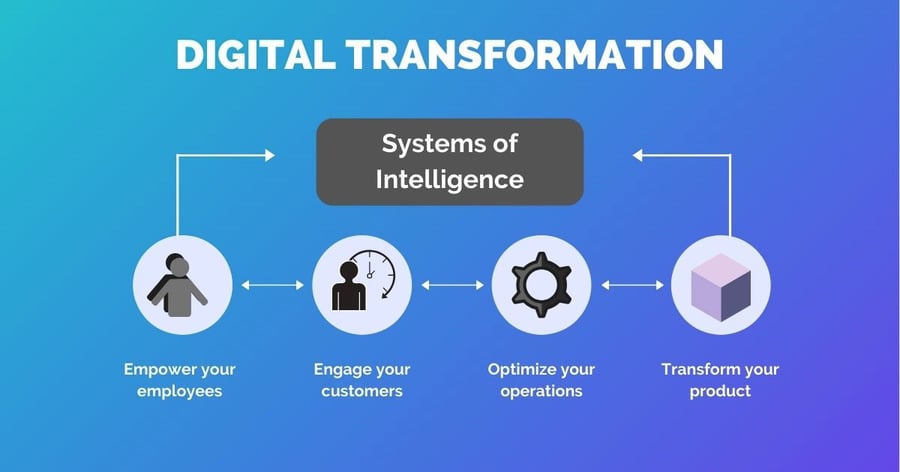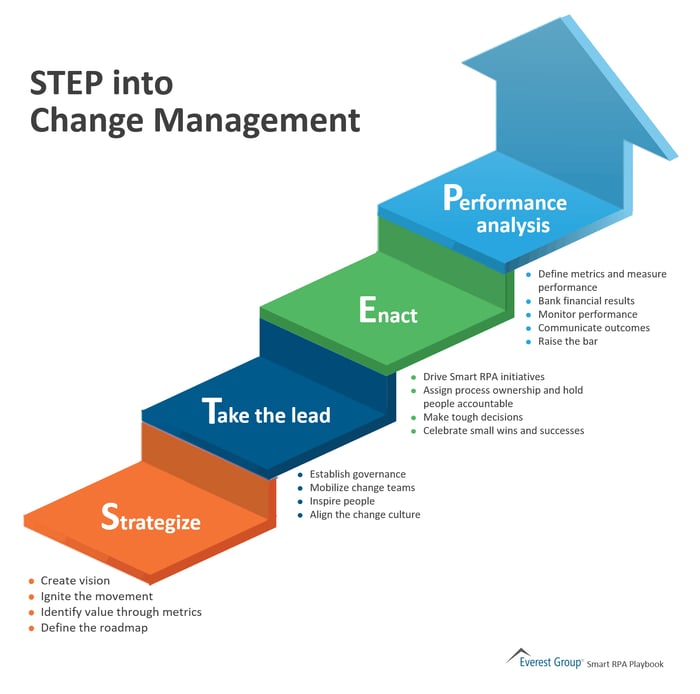
Leading into the start of 2023 is the perfect opportunity to take stock of your current operations and learn what works and what needs improving.
With data from the US Census Bureau indicating that an average of 4 million businesses enter the market each year, there's no room to stay stagnant. To maintain a competitive edge, you must adapt to industry trends and meet consumer demands.
But often, when we think about goals for our businesses, we tend to focus on what we want to achieve in the very short term. We might list things we need to do this week or month, like boost sales by 20%.
It's easy to forget about the longer-term goals that could make or break your business.
The new year is an excellent time to set transformative goals to help grow your business and evolve into a well-oiled, revenue-generating machine.
In this post, we'll share seven tips for setting transformative business goals for the new year to put you on the right track to achieve your long-term dreams and ambitions.
Let's dive in.
What is business transformation?
There are a lot of buzzwords out there, and it's easy to get lost in the jargon. But don't worry. We're here to help break it down for you.
Business transformation is a catch-all phrase that includes evaluating and changing how your organization runs.
These changes can include reorganizing your office space or implementing new technology that makes internal communication faster and more efficient.
It could also mean switching up your marketing strategy to target a new audience or adapting your business model to appeal to consumers with changing needs.
Business transformation is about improving techniques, processes, and technologies to work more efficiently. It requires understanding how alternate solutions can help gain market share, increase revenue, and boost customer satisfaction.
For instance, if you own a keto diet blog, one transformative approach is installing essential plugins on your site to improve the user experience.
A revolutionary recipe card plugin can help create aesthetically pleasing recipes at the bottom of each blog post. After the installation, your readers can easily access ingredients, instructions, and other important notes to make the perfect keto meal or share it with their friends and family.
In short, a successful business transformation will help you grow and thrive as a business while making sure you're doing right by your employees and customers.
Types of Business Transformation
All business transformations begin with the question of how your enterprise creates value today and how it'll continue to create value in the future.
The business world is changing faster than ever, and it's only getting more competitive. While you may be succeeding today, you can't afford to stand still.
You need to think big to win in the future. Your organization needs to be able to thrive today and five years from now.
So before you dive into setting your transformative business goals for the new year, it's essential to understand the different types of business transformation.
Let's take a look at the five primary types of business transformation so you can decide where you can focus your energy.
Digital Transformation
You've probably heard the term "digital transformation" floating around, but what exactly does it mean?
Digital transformation focuses on improving or adding technology to your current workflow to unlock additional value. The goal of digital transformation is to make your business more agile, efficient, and customer-centric — a must in today's world.
You'll need to keep up with the ever-changing landscape of technology, or else you risk missing out on new business opportunities or even losing existing customers.
Implementing new tech tools and automating specific tasks will allow your business to optimize its processes and increase efficiency and productivity.

Source: DITRAMA
For example, adding a dynamic report builder to your tech stack allows your employees to streamline the reporting process while simultaneously reducing human errors.
As a result, your internal and external stakeholders are happier with error-free, custom reports. Your employees now have more time to work on other vital projects to grow your business.
Business Process Transformation
Business process transformation focuses on improving your organization's business processes to be more efficient, effective, and aligned with your other strategic goals.
Companies may decide to undergo this type of transformation because they want to increase their productivity or reduce costs. They also may want to improve their responsiveness to customers' needs or make their operations more efficient.
It's an ongoing effort using software and technologies to make your company's business more efficient or with more skilled staff.
Organizational Transformation
Organizational transformation involves:
- Rethinking the structure within your organization to better meet current needs
- Improving collaboration between departments
- Finding the happy medium for optimal headcount
Take a look at the skills and experience of your staff, where they sit within the organization, and the various reporting structures to identify new opportunities.
Management Transformation
As companies strive to compete in a dynamic marketplace, top-down hierarchies only sometimes foster fast decision-making or quick responses to new developments.
Management transformations move power from traditional hierarchies to flat structures where managers work with employees on projects instead of giving orders from higher up.
Your organization must be well-socialized, have access to the appropriate information and communication channels, and be transparent about its functions to be successful.
Cultural Transformation
Cultural transformation is arguably the most challenging form of business transformation.
Corporate cultures tend to evolve organically and can be difficult to change. It takes a long time because of the effort it takes to translate concepts and intentions into action and practice.
A strong vision and perseverance are essential for the success of your cultural transformation.
7 Tips for Setting Transformative Business Goals for the New Year
Aligning all the elements to get business transformation "right" requires an integrated approach linking business strategy to transformation ambition and execution discipline.
Use these seven tips to help you set transformative business goals for the new year and unlock breakthrough value for your organization.
1. Reflect on the prior year.
The first step in setting business goals is to reflect on your company's performance over the last year.
Ask yourself some of these questions:
- What went well?
- What didn't go as planned?
- What were your biggest challenges?
- Are there any growth opportunities?
- Did you experience any bottlenecks in your workflow?
- Were you adequately staffed with headcount and experience?
- Were your customers happy with your product or service?
By reviewing your business over the past year, you can identify areas where you need to adapt or change course to make progress and proceed forward.
For instance, if you noticed that your online reviews dropped from 4.5/5 stars to 4.0/5 stars, it's time to take a deep dive and understand the root cause of the issue.
The customer experience plays a significant role in overall satisfaction with a brand. It deals with many different touch points along the path to purchase.
Understanding where the bottleneck stems from and addressing the issue head-on is a surefire way to boost customer satisfaction, recuperate your positive reviews, and continue to grow your business to new heights.
2. Identify your capabilities.
Leaders of business transformation initiatives should focus on the capabilities they need to achieve competitive advantage.
According to Deloitte, there are six dimensions of enterprise capabilities:
- Mission: The reason behind your strategy, how to execute it, and your capacity to carry it out.
- Insights: A set of tools and processes that help you make better data-driven decisions.
- Integration: The roles, responsibilities, and decision-making authority across your organization.
- Processes: A smooth, efficient process that helps you reach your goals.
- Technology: The tech stack of hardware, software, and tools required to operate efficiently.
- Talent: The appropriate skills, experience, and headcount you need to have in place.
Only a few of an organization's total capabilities drive differentiation and competitiveness. Focus on those critical capabilities to help you achieve your business transformation goals.
3. Get leadership buy-in.
You want your leadership team to be excited about the vision for the new year.
Why? Because if they buy into these goals, they can help make them happen. The C-Suite plays a key role in defining the company culture and core values, so getting them on board with your business transformation plans is important.
In fact, leadership attitudes are directly linked to employee engagement levels, according to research by Quantum Workplace.

Source: Quantum Workplace
You should involve them in every step of goal-setting: from defining outcomes, choosing the metrics to use to track performance, and getting feedback on goals and objectives.
4. Consider your employees' goals and objectives.
Once you have the green light from your leaders, you'll need to consider the needs of your employees.
- Are they satisfied with their current positions? If so, what is motivating them to stay? If not, what needs to change?
- Do they have ideas for new projects or initiatives to help the company grow?
- Are there particular skill sets or talents they'd like to develop further?
According to employees, the most important indicators of a good employer are competitive pay and good leadership. However, benefits, flexible schedules, and growth opportunities are critical to give you an edge over competitors and keep employees engaged.
Once you know your team members' motivations and how they can contribute to organizational goals, create roadmaps to show them how their job is essential and contributes to the business.
By informing employees about why the changes are necessary, you can expect them to work towards the same goals.
Your people are your best assets. Instead of making them feel like a cog in the machine, thank them for their efforts. Remind them that their skill sets and expertise move the needle toward the end goal.
5. Create a sense of urgency.
You want your employees to be excited about change and potential growth opportunities, but you also need them to feel a sense of urgency.
We're creatures of habit. And most people prefer the known versus the unknown. Even if you have the best intentions and bulletproof plans to achieve your goals, you might notice a need for more urgency to get the ball rolling.
Avoid the slow start towards implementation by setting strict deadlines for each step in the process — and stick to them.
Why? If there's no immediate consequence for missing a deadline, people will continue doing what they've always done because it's easier and takes less effort to adopt change.
6. Reduce workplace uncertainty.
Many employees fear that business transformation projects will eliminate the need for their skills and expertise. These fears arise during digital transformation efforts because people believe new technology will replace them.
However, research shows that 52% of companies believe technology disruption has had a neutral-to-positive impact on job creation.
When introducing change, it's best to do so clearly and transparently — and reassure employees where possible.
Be prepared to answer questions from employees about these changes, especially if they are unfamiliar with them or are worried about how they'll affect them personally.
7. Establish an efficient change management process.
Managing changes is crucial to overall success when your business is transforming.
A change management process helps you track, measure, and analyze new changes and understand how they affect your organization.
Give training sessions to explain new processes and why they're necessary, even to people who won't be affected. If you do this, the new processes and policies will be more likely to be accepted.
For best results, follow the STEP method to change management:
- Strategize
- Take the lead
- Enact
- Performance analysis

Source: Everest Group
Wrapping Up
Your transformative business goals are the road map to your company's future.
But they're only as successful as your weakest link. So make sure you craft them carefully, with a deep understanding of your business and how it operates.
These tips for setting transformative business goals will help you make 2023 the best year — cheers to business prosperity in the new year.





Leave a reply or comment below